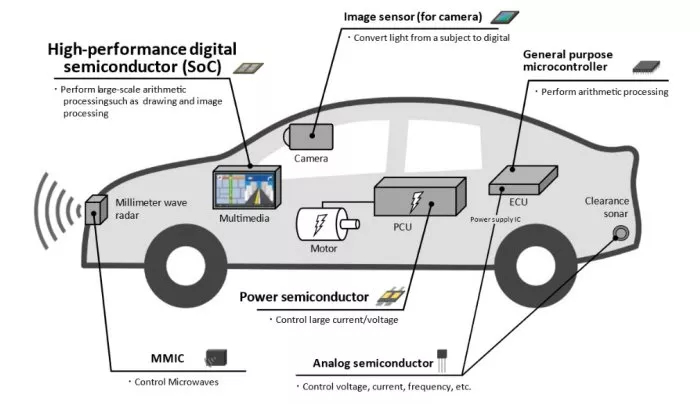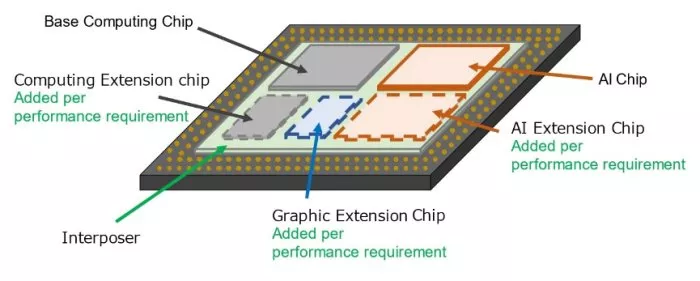Established "Advanced SoC Research for Automotive" with 12 companies, led by automotive manufacturers
December 28, 2023 -- Twelve companies, automotive, electrical component, and semiconductor companies established the "Advanced SoC Research for Automotive" (ASRA) on December 1st to conduct research and develop high-performance digital semiconductors (System on Chip, SoC) for use in automobiles. ASRA will research and develop SoCs for automobiles using chiplet technology to install SoC in mass-production vehicles from 2030 onward.
[Participating Companies] (in alphabetical order)
Automotive Manufacturers:
Honda Motor Co., Ltd., Mazda Motor Corporation,
Nissan Motor Corporation, SUBARU Corporation,
Toyota Motor Corporation
Electrical Component Manufacturers:
DENSO CORPORATION,
Panasonic Automotive Systems Co., Ltd.
Semiconductor Companies:
Cadence Design Systems, Japan,
MIRISE Technologies Corporation,
Renesas Electronics Corporation,
Socionext Inc., Synopsys Japan
Approximately 1,000 semiconductors are used in each automobile, and the types vary depending on the application. Among them, SoCs are essential semiconductors for autonomous driving technology and multimedia systems in automobiles, which require state-of-the-art semiconductor technology to achieve advanced computing power.

Examples of Semiconductors Used in Cars
ASRA will pursue the high level of safety and reliability required for automobiles by having automakers play a central role. Also, by bringing together the technological and experiential knowledge of electrical components and semiconductor companies, ASRA will aim to apply cutting-edge technologies practically. Specifically, ASRA plans to research and develop SoCs for automobiles using chiplet technology and combining different semiconductor types.
[Advantages of Chiplet Technology]
(1) Higher performance and multifunctionality
(2) Higher yield chips
(3) Timely commercialization of SoCs with functions and performance optimized for end-user (automotive companies) requirements

Image of Chiplet Technology
ASRA aims to establish in-vehicle chiplet technology by 2028 and to install SoCs in mass-produced vehicles from 2030 onward. By combining Japan's technological capabilities and experience in automotive, electrical components, and semiconductors, ASRA will work with industry, government, and academia to promote domestic and international collaboration as a world-leading technology research group.
Outline of Advanced SoC Research for Automotive
| Date of Establishment | December 1st, 2023 |
| Chairman | Keiji Yamamoto (Senior Fellow, Toyota Motor Corporation) |
| Executive Director | Nobuaki Kawahara (Senior Advisor, DENSO CORPORATION) |
| Members | Automotive Manufacturers: Honda Motor Co., Ltd., Mazda Motor Corporation, Nissan Motor Corporation, SUBARU Corporation, Toyota Motor Corporation Electrical Component Manufacturers: DENSO CORPORATION, Panasonic Automotive Systems Co., Ltd. Semiconductor Companies: Cadence Design Systems, Japan, MIRISE Technologies Corporation, Renesas Electronics Corporation, Socionext Inc., Synopsys Japan |
| Headquarters Location | Nagono Campus, 2-14-1 Nagono, Nishi-ku, Nagoya, Aichi, Japan |
| Business Activities | Research and development of automotive SoC applying chiplet technology |
Related Chiplet
- Interconnect Chiplet
- 12nm EURYTION RFK1 - UCIe SP based Ka-Ku Band Chiplet Transceiver
- Bridglets
- Automotive AI Accelerator
- Direct Chiplet Interface
Related News
- Cadence Accelerates SoC, 3D-IC and Chiplet Design for AI Data Centers, Automotive and Connectivity in Collaboration with Samsung Foundry
- Renesas Unveils Industry’s First Automotive Multi-Domain SoC Built with 3-nm Process Technology with Chiplet Extensions
- ITF World 2025: Imec’s Vision for Automotive Over the Long Haul
- ASE Announces FOCoS-Bridge With TSV; Latest Package Technology Reduces Power Loss by 3x for Next-Generation AI and HPC Applications
Latest News
- Marvell Eyeing Connectivity as the Next Big Thing in AI
- Rebellions and Red Hat Introduce Red Hat OpenShift AI Powered by Rebellions NPUs to Fuel Choice and Flexibility in Enterprise AI
- Arteris to Expand Portfolio with Acquisition of Cycuity, a Leader in Semiconductor Cybersecurity Assurance
- CEA-Leti & STMicroelectronics’ Paper at IEDM 2025 Demonstrates Path to Fully Monolithic Silicon RF Front-Ends with 3D Sequential Integration
- Qualcomm Acquires Ventana Micro Systems, Deepening RISC-V CPU Expertise